17 MIN READ
Identification of Midwestern Corn Disease
February 21, 2021
The potential for corn seeds and plants to become infected with a disease is greatly determined by genetics, use of fungicidal seed treatments, environmental conditions, time in the growing season, and the presence of casual agents (fungal or bacterial pathogens, viral vectors, and nematodes).
Newly planted seeds are immediately subjected to pathogenic fungi and bacteria that inhabit the soil. In general, these pathogens have a greater potential for causing damage when soils are wet and cold; however, some pathogens prefer warm conditions. Infected seedlings may show signs of damping-off or rotting, stunting, yellowing leaves or loss of color, and deformities.
Susceptibility to diseases depends largely on the level of genetic resistance to a disease. Some seed products can have nearly complete resistance while others are very susceptible. When selecting seed products for planting, the historical disease presence should be considered, and seed selections made accordingly.
Foliar fungal diseases may become apparent anytime during the season depending on the presence of the pathogen. Many fungal pathogens can overwinter on or in infected residue and can contact plants via splashing rain or wind. Some fungal pathogens that are unable to overwinter can be carried from warmer southern areas into the Midwest on wind currents. Depending on the disease, foliar fungicides may provide control.
Bacterial diseases can also overwinter on infected residue. The bacterium can contact plants through water movement in the soil, splashing rain, wind-driven rain, and mechanical means such as cultivating when plants are wet. Infection occurs when bacterium enter the plant through wounds or natural tissue openings such as stomates.
Viral diseases rely on a vector such as aphids or thrips to infect a plant. As the vector feeds, infected juices are injected into plant tissue. Scouting for insects that have the potential to vector viral diseases and applying a timely insecticide may help protect plants from becoming infected via insect feeding. Caution should be taken not to spray insecticides without proper identification as many beneficial insects can be killed.
Additional harvest-time diseases include stalk and ear rots. Stalk rots can result in lodging that can diminish harvest speed, increase harvesting equipment wear and tear, decrease grain quality, and increase the potential for personal injury. Ear rots can affect grain quality, test weight, and marketability. Some ear rots produce toxins that can be harmful or even lethal to livestock and humans.
Nematodes are often discussed under the disease umbrella; however, they are microscopic parasitic worms that live outside (ectoparasitic) or within (endoparasitic) corn roots. Nematode infestations may go unnoticed, particularly under favorable growing conditions, or cause stunting, nutrient deficiencies, and create entrance wounds for other pathogens.
Click below on Seed and Seedling, Foliar, or Corn Nematodes to identify and learn about the corn diseases on your farm.
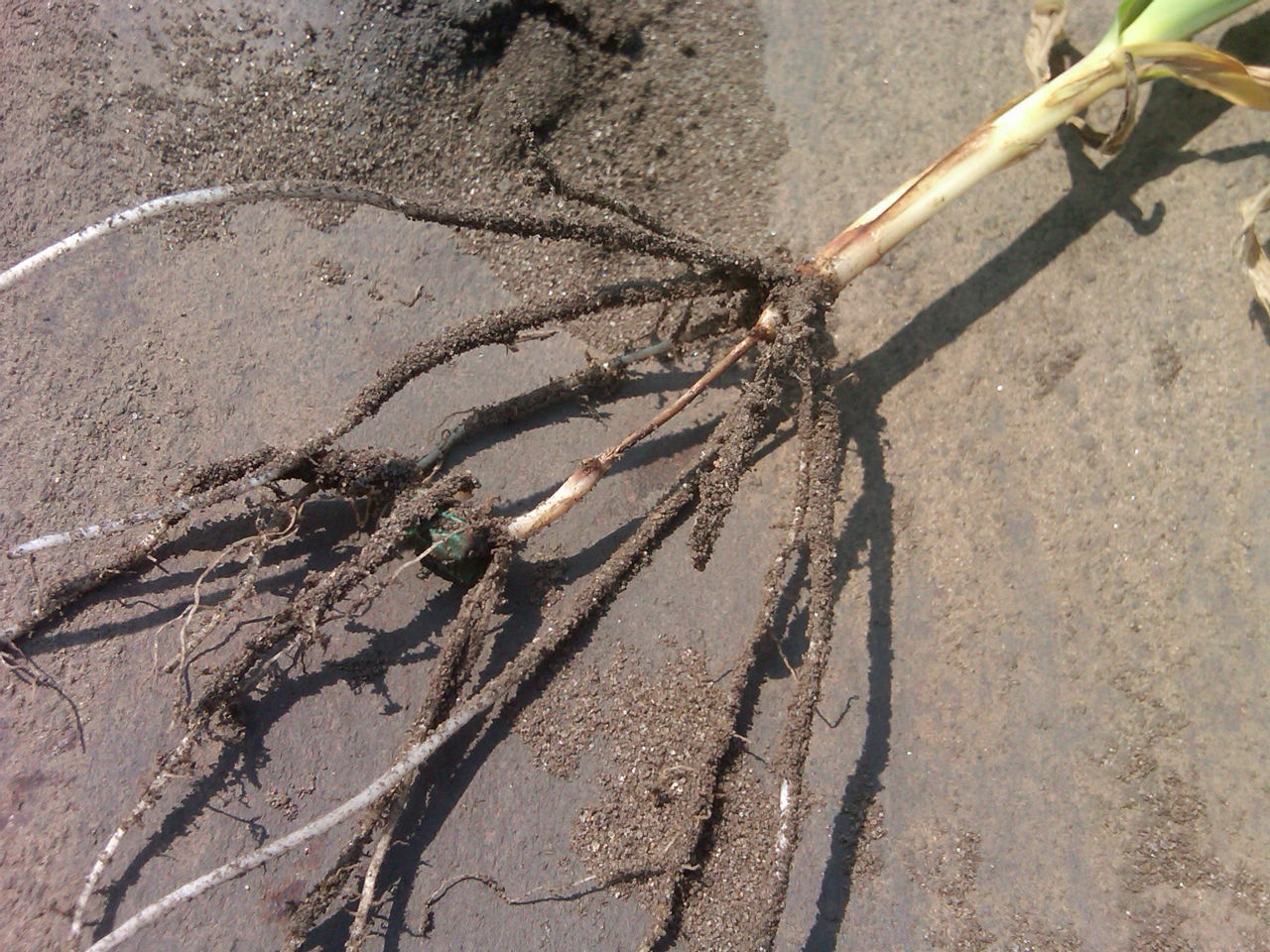
Identification, Characteristics, and Diagnosis:
Caused by at least six Fusarium species.
Initially, infected seedling roots and the mesocotyl may be shriveled and have tan to reddish-brown lesions, which later become brownish to dark black and rotted.
Favored by wet and cool (55° F or lower) soils.
Most notable in early planted and reduced tillage fields.
Management:
Utilize fungicide-protected seed.
Plant into warm soils that are favorably dry.
Planting depth should not be too deep.
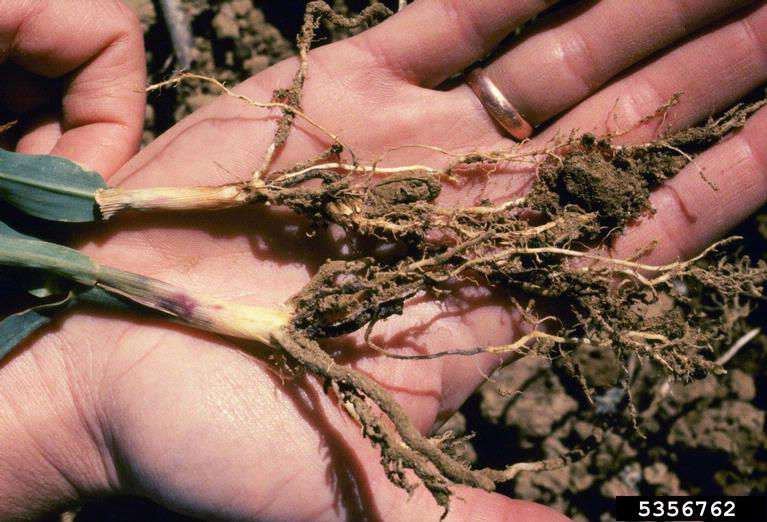
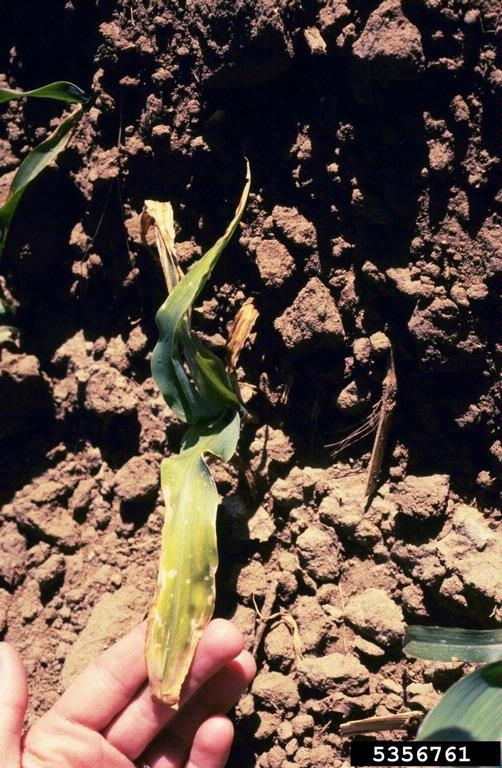
Identification, Characteristics, and Diagnosis:
Caused by the fungus Penicillium oxalicum.
A bluish-green mold develops on seed causing roots to deteriorate (top).
Seedling leaves turn yellow and may die (bottom).
Favored by wet and cool (55° F or lower) soils.
Most notable in early planted and reduced tillage fields.
Management:
Utilize fungicide-protected seed.
Plant into warm soils that are favorably dry.
Planting depth should not be too deep.
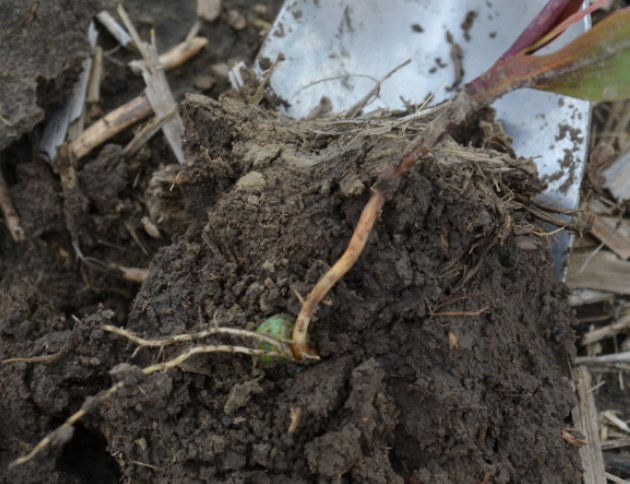
Identification, Characteristics, and Diagnosis:
Caused by several Pythium species.
Favored by wet and cool (55° F or lower) soils.
Symptoms include dark, slimy lesions that cause roots or the mesocotyl to shrivel and the outer layer of roots may be rotted while inner tissues remain white and intact.
Most notable in early planted and reduced tillage fields.
Can infect anytime from planting to mid-season.
Management:
Utilize fungicide-protected seed.
Plant into warm soils that are favorably dry.
Planting depth should not be too deep.
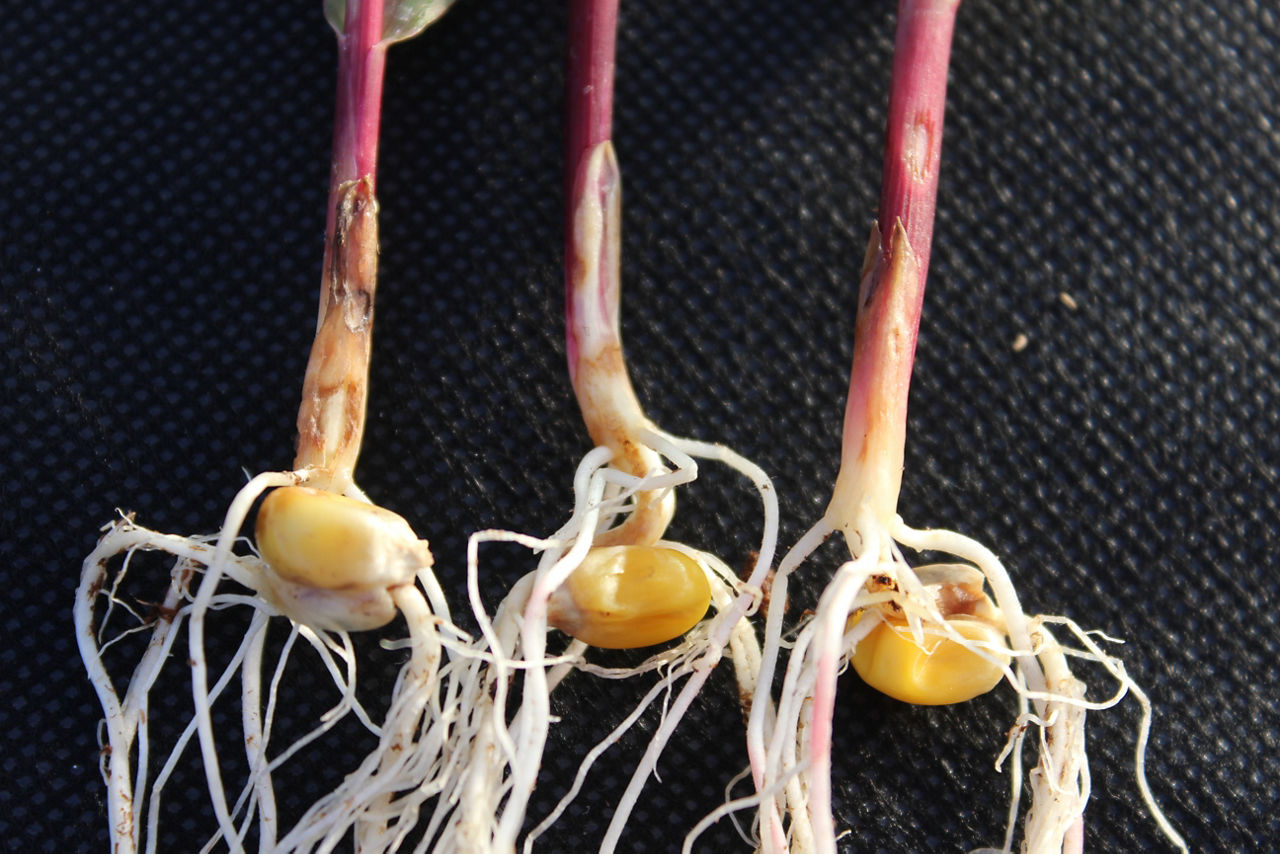
Identification, Characteristics, and Diagnosis:
Caused by the fungus Rhizoctonia solani.
Initial symptoms include brown lesions on the mesocotyl and roots of seedlings and young plants.
Later symptoms on older plants include reddish-brown, sunken cankers on crown and brace roots.
Plants may be stunted, chlorotic, or have no above ground symptoms.
Occurs more often in irrigated fields.
Favored by temperatures between 46 to 82° F.
Management:
Utilize fungicide-protected seed.
Plant into warm soils that are favorably dry.
Planting depth should not be too deep.
Click below on Viral, Stalk Rots, or Ear Rots to identify and learn about the corn diseases on your farm.
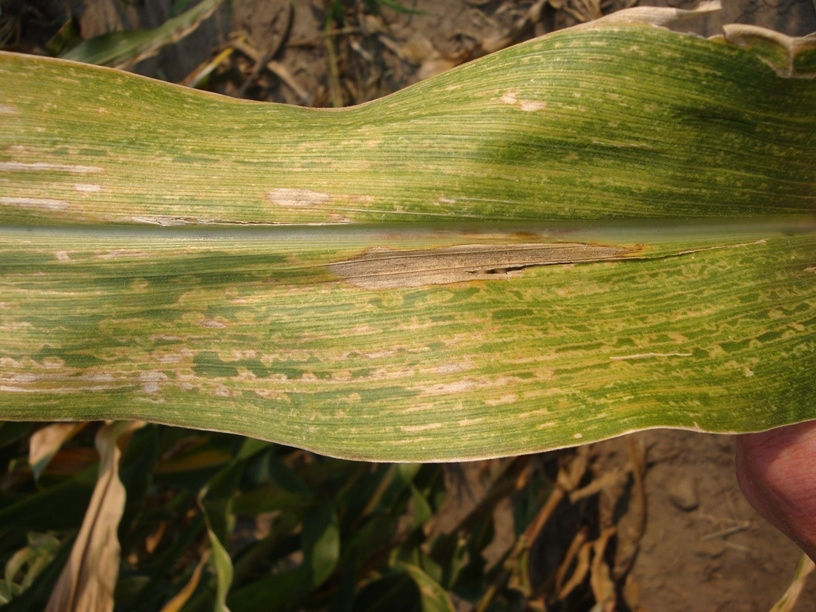
Identification, Characteristics, and Diagnosis:
- Occurs when Maize chlorotic mottle virus (MCMV) and Sugarcane mosaic virus (SCMV) (formerly Maize dwarf mosaic virus (MDMV-B)) or Wheat streak mosaic virus (WSMV) infect the same plant.
- The combination of MCMV and SCMV is more frequent.
- Symptoms of the combination appear as a bright greenish-yellow leaf mottling that lasts until the end of the growing season.
- Plants are susceptible at all stages of growth.
- Coloration is usually not noticed until late June or early July and only occurs on the leaves that emerge after infection occurs.
- Plants infected late in the season may exhibit poorly filled ears, have premature husk death, and lack leaf mosaic symptoms.
MCMV may be vectored by corn rootworm beetles (Diabrotica species) (laboratory research) and/or thrips (Franklinella species) (Hawaiian breeding nursery). Research has also noted a possible soil-borne mechanism for overwintering.
SCMV is vectored by greenbugs (Schizaphis species) and corn leaf aphids (Rhopalosiphum maidis).
WSMV is vectored by the wheat curl mite (Aceria tosichella (K.)).
Corn lethal necrosis has been identified in North Central Kansas and South Central Nebraska.
Management:
Scout for and manage the occurrence of greenbugs.
Crop rotation can greatly reduce the incidence of MCMV.
Plant seed products that demonstrate higher levels of tolerance.
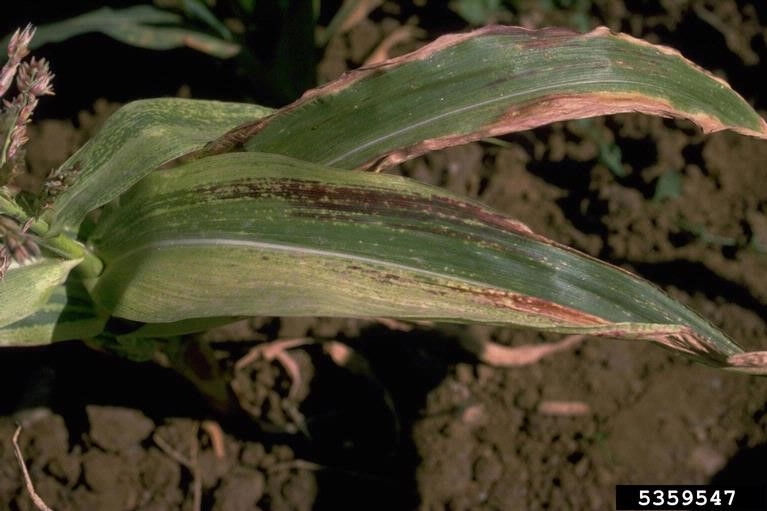
Identification, Characteristics, and Diagnosis:
Vectored by wheat curl mite (Aceria tosichella (K.)).
In the United States, the disease is found primarily in Eastern Nebraska to Western Idaho and from the Texas Panhandle to Central South Dakota.
Symptoms can vary depending on genetics, environment, timing of infection, and the complex of viruses.
Symptoms can include chlorotic spots on the leaves, stunting, and purple leaf tips and margins. Chlorotic spots form on lower leaves first and progress up the plant. Spots tend to form along vascular bundles in a linear fashion.
Usually occurs along with Wheat streak mosaic virus because they share the same insect vector.
Management:
Scout for and manage the occurrence of wheat curl mites.
Plant seed products that demonstrate higher levels of tolerance.

Identification, Characteristics, and Diagnosis:
Symptoms include light-greenish mottling (alternating light- and dark-green areas) of leaves.
Symptomology resembles those of Maize dwarf mosaic virus (MDMV).
Largely a South American disease until discovered in North Central Kansas. Has also occurred in South Central Nebraska and Hawaii.
MCMV may be vectored by corn rootworm beetles (Diabrotica species) (laboratory research) and/or thrips (Franklinella species) (Hawaiian breeding nursery). Research has also noted a possible soil-borne mechanism for overwintering.
The disease has the potential to dramatically affect yield potential.
Favored by high temperatures and wet conditions.
Management:
Scout for and manage the occurrence of corn rootworm beetles.
Crop rotation can greatly reduce the incidence of MCMV.
Plant seed products that demonstrate higher levels of tolerance.

Identification, Characteristics, and Diagnosis:
Symptoms include light-greenish mottling (alternating light- and dark-green areas) of leaves.
Symptomology resembles those of Maize dwarf mosaic virus (MDMV).
Largely a South American disease until discovered in North Central Kansas. Has also occurred in South Central Nebraska and Hawaii.
MCMV may be vectored by corn rootworm beetles (Diabrotica species) (laboratory research) and/or thrips (Franklinella species) (Hawaiian breeding nursery). Research has also noted a possible soil-borne mechanism for overwintering.
The disease has the potential to dramatically affect yield potential.
Favored by high temperatures and wet conditions.
Management:
Scout for and manage the occurrence of corn rootworm beetles.
Crop rotation can greatly reduce the incidence of MCMV.
Plant seed products that demonstrate higher levels of tolerance.

Identification, Characteristics, and Diagnosis:
Symptoms include light-greenish mottling (alternating light- and dark-green areas) of leaves.
Symptomology resembles those of Maize dwarf mosaic virus (MDMV).
Largely a South American disease until discovered in North Central Kansas. Has also occurred in South Central Nebraska and Hawaii.
MCMV may be vectored by corn rootworm beetles (Diabrotica species) (laboratory research) and/or thrips (Franklinella species) (Hawaiian breeding nursery). Research has also noted a possible soil-borne mechanism for overwintering.
The disease has the potential to dramatically affect yield potential.
Favored by high temperatures and wet conditions.
Management:
Scout for and manage the occurrence of corn rootworm beetles.
Crop rotation can greatly reduce the incidence of MCMV.
Plant seed products that demonstrate higher levels of tolerance.

Identification, Characteristics, and Diagnosis:
Symptoms include light-greenish mottling (alternating light- and dark-green areas) of leaves).
Symptomology resembles those of Maize dwarf mosaic virus (MDMV).
Largely a South American disease until discovered in North Central Kansas. Has also occurred in South Central Nebraska and Hawaii.
MCMV may be vectored by corn rootworm beetles (Diabrotica species) (laboratory research) and/or thrips (Franklinella species) (Hawaiian breeding nursery). Research has also noted a possible soil-borne mechanism for overwintering.
The disease has the potential to dramatically affect yield potential.
Favored by high temperatures and wet conditions.
Management:
Scout for and manage the occurrence of corn rootworm beetles.
Crop rotation can greatly reduce the incidence of MCMV.
Plant seed products that demonstrate higher levels of tolerance.
Sources:
Robertson, A. and Munkvold. G. 2000. Check general root and mesocotyl health when assessing corn stands. Iowa State University Extension. https://crops.extension.iastate.edu/.
Jackson-Ziems, T. and Korus, K. 2013. Seedling diseases appearing in corn. University of Nebraska. https://cropwatch.unl.edu.
Sweets, L. and Wright, S. 2008. Corn diseases. University of Missouri. https://ipm.missouri.edu.
Compendium of corn diseases. 1999. APS Press.
Jackson-Ziems, T. Bacterial leaf streak. CROPWATCH. University of Nebraska. https://cropwatch.unl.edu.
Jackson-Ziems, T. Goss’s bacterial wilt and leaf blight. CROPWATCH. University of Nebraska. https://cropwatch.unl.edu.
Thomas-Murphy, J. Stewart’s bacterial leaf blight. Cornell University. https://fieldcrops.cals.cornell.edu/.
Malvick, D. 2018. Holcus spot on corn. University of Minnesota Extension. https://extension.umn.edu/.
Bissonnette, S. 2015. Another corn disease alert: New bacterial leaf disease ‘bacterial stripe’ (Burkholderia andropogonis) of corn identified in Illinois. Blog Archives. The Bulletin. University of Illinois. http://bulletin.ipm.illinois.edu/.
Bacterial stripe of corn (maize). Burkholderia andropogonis. Plant Diseases Caused by Bacteria – NARRATIVES. PlantDiseases.org. University of California, Berkeley. https://www.plantdiseases.org/.
Ernest, E. 2013. What causes black spots on corn stalks? University of Delaware.
Kleczewski, N. 2014. Anthracnose leaf blight and stalk rot of corn. Cooperative Extension. University of Delaware. http://extension.udel.edu/.
Stewart’s leaf blight of dent corn. RPD No. 201. 1995. Reports on Plant Diseases. Integrated Pest Management. University of Illinois. http://ipm.illinois.edu/.
Iriarte, F. and Robertson, A. 2009. Signs of crazy top in corn. ICM News. Integrated Crop Management. Iowa State University. https://crops.extension.iastate.edu/.
Malvick, D. 2018. Eyespot on corn. Corn Pest Management. University of Minnesota Extension. https://extension.umn.edu/.
Wise, K. 2010. Gray leaf spot. Diseases of Corn. BP-56-W. Purdue Extension. Purdue University. https://www.extension.purdue.edu/.
Jackson-Ziems, T.A. 2015. Northern corn leaf blight. NebGuide. G2270. Nebraska Extension. University of Nebraska. http://extensionpublications.unl.edu/.
Jackson, T. Physoderma brown spot. CROPWATCH. University of Nebraska – Lincoln. https://cropwatch.unl.edu/.
Red root rot. Extension & Outreach. University of Illinois. http://extension.cropsciences.illinois.edu/.
Salgado, J.D. and Paul, P.A. 2016. Common rust on corn. PLPATH_CER-02. Ohioline. Ohio State University Extension. The Ohio State University. https://ohioline.osu.edu/.
Wise, K. 2010. Common and southern rusts. Diseases of Corn. BP-82-W. Purdue Extension. Purdue University. https://www.extension.purdue.edu/.
Sweets, L. and Kallenbach, R. 2012. Black corn fields. Integrated Pest Management. University of Missouri. https://ipm.missouri.edu/.
Jackson, T. Common smut. Corn diseases. CROPWATCH. University of Nebraska-Lincoln. https://cropwatch.unl.edu/.
Head smut of corn. Crop Protection Network. https://cropprotectionnetwork.org/.
Jackson, T. Head smut. Corn Diseases. CROPWATCH. University of Nebraska-Lincoln. https://cropwatch.unl.edu/.
Corn smuts. RPD No. 203. 1990. Reports on Plant Diseases. Integrated Pest Management. University of Illinois. http://ipm.illinois.edu/.
Southern corn leaf blight of corn. Crop Protection Network. https://cropprotectionnetwork.org/.
Southern corn leaf blight. Field Crops. Extension & Outreach. University of Illinois. http://extension.cropsciences.illinois.edu/.
Bruns, H.A. 2017. Southern corn leaf blight: A story worth retelling. Agronomy Journal. Volume 109, Issue 4. American Society of Agronomy. https://www.ars.usda.gov/.
Common leaf blights and spots of corn. 1997. RPD No. 202. Reports on Plant Diseases. Integrated Pest Management. University of Illinois. http://ipm.illinois.edu/.
Wise, K., Ruhl, G., and Creswell, T. Tar spot. BP-90-W. Diseases of Corn. Purdue Extension. Purdue University.
Jardine, D.J. Corn lethal necrosis. Factsheets – Corn. Kansas State University. https://www.plantpath.k-state.edu/.
Zambrano, J.L., Stewart, L.P., and Paul, P.A. 2016. Maize dwarf mosaic of maize. PLPATH-CER-09. Ohioline. Ohio State University Extension. The Ohio State University. https://ohioline.osu.edu/.
Bissonnette, S. 2000. Wheat streak mosaic virus in field corn. The Bulletin. University of Illinois.
Jensen, S.G. The High Plains virus. A newly emerging problem of maize and wheat with world wide implications. University of Nebraska. https://nematode.unl.edu/.
Wheat-streak mosaic. 1989. RPD No. 120. Reports on Plant Diseases. Integrated Pest Management. University of Illinois. https://ipm.illinois.edu/.
Watkins, J. and Wegulo, S. Wheat streak mosaic virus. CROPWATCH. University of Nebraska-Lincoln. https://cropwatch.unl.edu/.
Common leaf blights and spots of corn. RPD No. 202. 1997. Reports on Plant Diseases. Integrated Pest Management. University of Illinois. https://ipm.illinois.edu/.
Freije, A., Wise, K., and Nielsen, B. 2016. Diseases of corn. Stalk rots. BP-89-W. Purdue Extension. Purdue University. https://www.extension.purdue.edu/.
Jackson-Ziems, T.A., Rees, J.M., and Harveson, R.M. Original author Stack, J.S. Common stalk rot diseases of corn. EC1898. University of Nebraska – Lincoln. https://extensionpuplications.unl.edu/.
Kellerman, T.S., Rabie, C.J., van der Westhuizen, G.C., Kriek, N.P., and Prozesky, L. 1985. Induction of diplodiosis, a neuromycotoxicosis, in domestic ruminants with cultures of indigenous and exotic isolates of Diplodia maydis. PubMed.gov. US National Laboratory of Medicine. National Institutes of Health. NCBI. https://www.ncbi.nlm.hih.gov/.
Thomison, P., Lohnes, D., Geyer, A., and Thomison, M. Troubleshooting abnormal corn ears. The Ohio State University. https://u.osu.edu/.
Robertson, A. 2004. Corn ear rots. Iowa State University. Integrated Crop Management Newsletter. IC-492(21). https://www.ipm.iastate.edu/.
Jackson, T. and Ziems, A. 2009. Corn ear rots and grain molds. CropWatch. University of Nebraska-Lincoln. http://cropwatch.unl.edu/.
Munkvold, G.P. 2002. Corn ear molds and mycotoxins. Integrated Crop Management News. 1712. IC-488(22). Iowa State University. http://lib.dr.iastate.edu/.
Paul, P. and Mill, D. 2009. Corn ear rot: Which one is it? Ohio State University. C.O.R.N. Newsletter 2009-35. https://agcrops.osu.edu/.
Corn ear and kernel rots. 1991. Integrated Pest Management. RPD No. 205. University of Illinois. http://ipm.illinois.edu/.
Grabau, Z. and Vann, C. 2017. Management of plant parasitic nematodes in Florida field corn production. ENY-001. University of Florida. http://edis.ifas.ufl.edu.
Ziems, T. 2015. Sampling for nematodes of corn. University of Nebraska-Lincoln. http://cropwatch.unl.edu.
Tylka, G. 2007. Nematodes in corn production: a growing problem? IC-498. Iowa State University Extension. http://www.ipm.iastate.edu.
Niblack, T. 2003. More details on corn nematodes. University of Illinois. http://bulletin.ipm.illinois.edu. Norton, D. and Nyvall, R. 2011. Nematodes that attack corn in Iowa. PM1027. Iowa State University. Tiwari, Siddharth, Eisenback, J.D., and Youngman, R.R. Root-knot nematode in field corn. Publication 444-107. Virginia Cooperative Extension. Virginia Tech. Virginia State University.
Norton, D.C. and Nyvall, R.F. 2011. Nematodes that attack corn in Iowa. PM1027. Iowa State University. Tylka, G. 2007. New cyst nematode species on corn. IC-498(21). Integrated Pest Management. Iowa State University. https://crops.extension.iastate.edu.
The ectoparasitic nematodes of Illinois. RPD No. 1106. Report on Plant Disease. 1997. University of Illinois Extension. https://ipm.illinois.edu/.
Web sites verified 8/28/19.
1010_G2